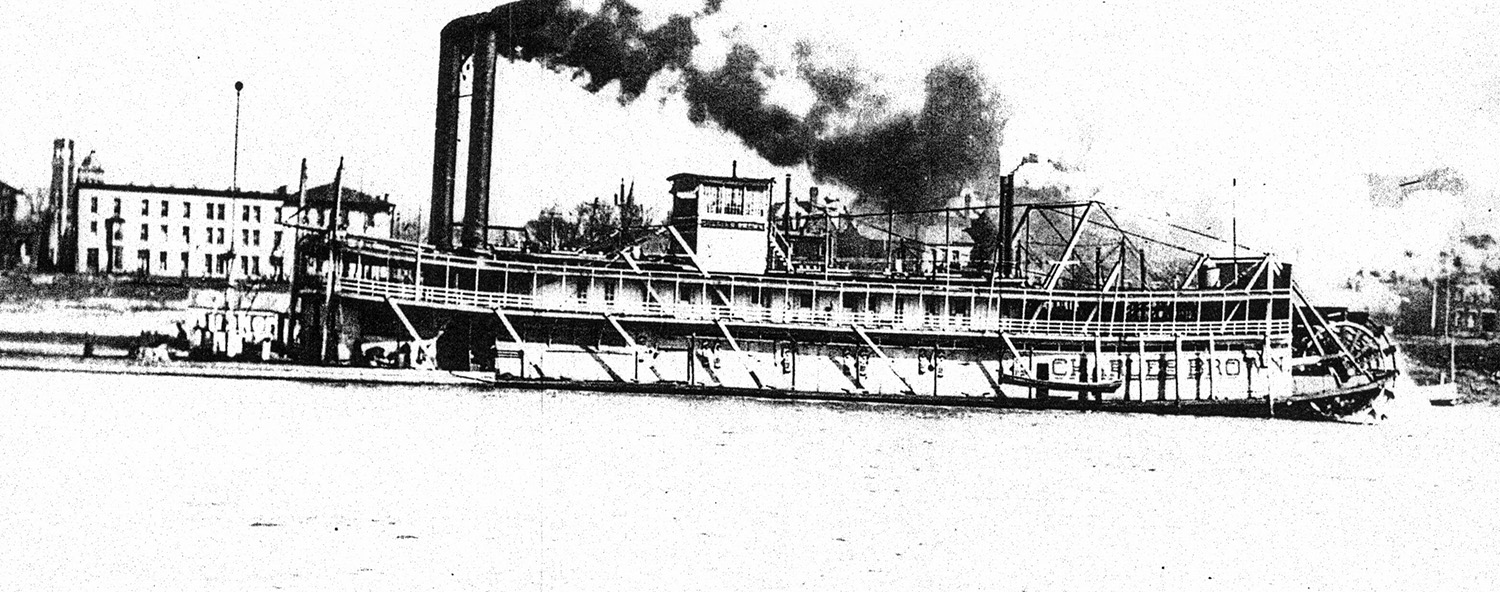Built in 1872 at Pittsburgh, the Charles Brown was owned by the firm of W.H. Brown & Sons.
Constructed on a wooden hull measuring 200 feet in length by 33 feet in width, the sternwheeler was nicknamed the ”Long Charlie” by river people. Five boilers provided steam to engines having 22-inch cylinders with an 8-foot stroke.
As with the other towboats of the Brown Line, the boat carried a huge ornamental anchor between the stacks. The riverboat was noted for having one of the first steam steering gears to be utilized on an inland river steamboat.
The boat was rated at 544 gross and net tons, with a crew of 21 employed. A small pilotwheel, about 30 inches in diameter, was mounted in back of the large one, controlling a steam winch engine beneath the pilothouse; it was reportedly a very noisy contraption.
The first master of the towboat was Capt. Luster Parker Chester, who, with his father in 1845, was a pioneer steamboatman aboard the Ploughman on the Youghiogheny River.
As with nearly all riverboats, the Charles Brown had its trials and tribulations. On January 23, 1898, the towboat encountered a severe storm near Vevay, Ind., on the Ohio River. Seven coal boats, one barge and a fuel flat were lost at a reported cost of $13,500. The towboat Sam Brown collided with the Charles Brown on February 5, 1903, near Gallipolis, Ohio; one coal boat was sunk, with a loss of $1,200. The accident was attributed to a large accumulation of driftwood under the barges and a heavy fog.
Fire broke out while the vessel was laid up, cleaning boilers, at Brown’s Coal Elevator in Cincinnati on July 5, 1901. The blaze gutted the pilothouse, a portion of the roof and forward cabin; repairs cost $2,500. Another fire occurred on March 16, 1906, at Lysle’s Landing near Allegheny, Pa., partially destroying the boat, with damages estimated at $15,000. Capt. Fred Dippold was master at that time.
Several tragedies plagued the steamboat. In 1890, Capt. William Dravo, master, died of injuries sustained when he slipped from the icy fantail and fell into the paddlewheel. Dravo was the father of Capt. Norman Dravo, who was pilot of the big towboat Joseph B. Williams. In the spring of 1899, two hunters in a canvas boat attempted to board the riverboat while it was under way. The canvas boat upset and one of the men, Wilmot Francy, was drowned. Capt. Daniel Woodward, age 45, while serving as master, was stricken with appendicitis while on watch in 1906. Woodward, a resident of Charleston, W.Va., was taken off the boat at East Liverpool, Ohio, where he subsequently died.
The Charles Brown became part of the famous Combine firm in 1900. In 1917, the boat was chartered to the Island Creek Coal Company of Huntington, W.Va. In January 1918, under the command of Capt. James Woodward, the riverboat was caught in heavy ice at Cincinnati, where it was crushed and sunk. No attempts to salvage the vessel were made.
Editor’s note: For questions or suggestions regarding the Old Boat Column, Keith Norrington may be contacted by e-mail at curatorkeith@yahoo.com, or by mail through the Howard Steamboat Museum at P.O. Box 606, Jeffersonville, Ind. 47131-0606.



